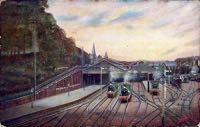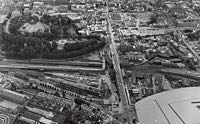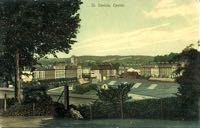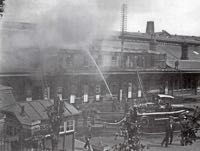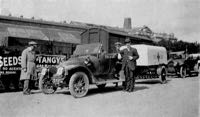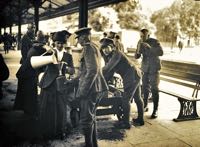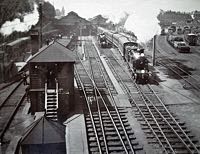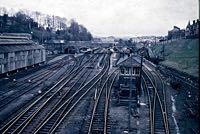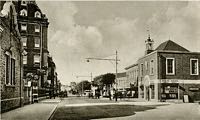
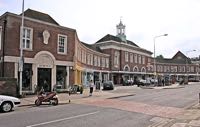 Central
Station - Queen Street
Central
Station - Queen Street
Formerly known as Queen Street Station
Page updated 19th February 2018
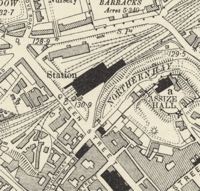 It was sixteen years
after the opening of the Bristol & Exeter Railway to St David's
Station, that a second route between London and Exeter, was opened for
traffic on the 18th July 1860. The chairman and directors of the
London and South Western Railway travelled from Yeovil on a special
train, cheered at each intermediate station towards Exeter. They were
greeted by the Mayor Mr T Drake with a short speech, while the citizens
of the city were granted a public holiday. The Chairman and directors
were entertained in a marquee in Northernhay with a banquet. The line
opened for goods traffic on the 1st August.
It was sixteen years
after the opening of the Bristol & Exeter Railway to St David's
Station, that a second route between London and Exeter, was opened for
traffic on the 18th July 1860. The chairman and directors of the
London and South Western Railway travelled from Yeovil on a special
train, cheered at each intermediate station towards Exeter. They were
greeted by the Mayor Mr T Drake with a short speech, while the citizens
of the city were granted a public holiday. The Chairman and directors
were entertained in a marquee in Northernhay with a banquet. The line
opened for goods traffic on the 1st August.
The new line ran from Waterloo via Salisbury and Yeovil, and utilised the Longbrook Valley for a route into the city. Initially the new station, named Queen Street Station, was a terminus, and it was not until 1st February 1862 that the short link between the two stations was opened. The link climbed towards Queen Street station, crossing the Bonhay Road on a 1 in 37 incline.
One correspondent to the Flying Post wondered why St David's Station was being rebuilt, in the light of the fine new facility at Queen Street. He went on to suggest that broad-gauge should be abandoned and that Queen Street should be the main station used by both railway companies to London. He was right about broad-gauge, but both lines continue to serve Exeter.
The short section of line from New North Road and the station lay in the northern moat of Rougemont Castle. The station had one platform covered by a wooden train shed. In 1874, two through lines were added and a more elaborate wrought iron trussed, wood clad shed was constructed over the lines.
The Great War
Through the First World War, Queen Street was used by many troop trains between Falmouth and Salisbury. On 22nd October 1914, 32,000 Canadian troops and 7,679 horses passed through Queen Street en route to Salisbury Plain before they were sent to the front. More tragic passengers were returned from the front to the Exeter VAD hospitals via Queen Street Station. Wounded soldiers disembarked to be taken to their respective hospital by cars hauling ambulance trailers. Each trailer could take two stretcher cases, while three walking wounded would be ferried in the car. In 1917 troops would disembark suffering from gas poisoning. They would walk, blinded by the gas in a long crocodile, holding on to the man in front before being taken to their designated VA Hospital. One arrival was described thus:
"... Drawn up outside the entrance to the platform at Queen-street Station were motor cars—some 25 in number—lent by various residents of the city, as well as a couple of carriages. The general public were not admitted to the platform, but huge crowds lined the vicinity of the station and the route to be traversed by the cars containing the wounded. The soldiers arrived in special carriages attached to the express train due at Queen-street at 4.10 p.m.. Some time previous to its arrival stretchers had been brought to the platform in readiness for those who might be unable to walk to the waiting cars. When the train arrived the carriages containing the wounded were shunted to one of the branch lines, in order that the ordinary train might be dispatched first, thus expediting the detraining of the wounded. Before this was accomplished, however, the Press representatives managed to distribute cigarettes among the men, which they much enjoyed…
Exeter and Plymouth Gazette - Thursday 8 October 1914
Goods yards were positioned on the northern side of the station with an entrance from the top end of Queen Street, close to the Clock Tower. In 1923 the line was absorbed in the Southern Railway and then into British Railways Southern Region in 1948.
It wasn't until 1925 that any more improvements were made to Queen Street when the up platform was lengthened to 1,210 ft to cater for increased passenger traffic to Exeter. However, the wooden buildings were deteriorating, requiring frequent repair and maintenance.
Severe fire
The inevitable happened on the morning of the 3 June 1927 when a fire severely damaged the buildings. At about 10am, Miss Ethel Handfield who worked in the refreshment rooms was informed by a member of the station staff that a fire had broken out above the staff bedrooms. She, and her manager, Mr W F Smith, rushed upstairs to fight the fire. Smith went on the roof with a fire extinguisher. Miss Handfield lost sight of him and called for help. PC Brown came up the stairs but was forced back by the flames, followed by Miss Handfield. PC Brown was severely burnt on his head and arms. Fireman Mogridge was injured when a ladder slipped and he fell into a roadway. The fire was extinguished by about 11am, leaving the refreshment room and staff bedrooms above severely damaged.
Although the damage was limited, questions were asked as to whether the rest of the station should remain as a timber structure. This editorial from the Exeter and Plymouth Gazette gives quite a lot of background information about the station and its problems.
"The fire at Queen Street Station, Exeter, may lead the Southern Railway Company to hasten its plans, which are believed to have been in existence for some time, for building a new station in place of the present structure, which is poor in appearance, very unsubstantial, and no means convenient in its arrangements for the travelling public. The station had narrow escapes when fires occurred at the old Victoria Hall (the shell of which has been utilised for the new showrooms, etc., of Messrs. Rowe Bros, and Co.) and at the timber yard at the western side of Queen-street. The latter fire, which occurred about 17 years ago, was particularly threatening, as flames from the timber yard swept through the block of premises chiefly occupied now, as then, by Messrs. Hibberd and Co., and scorched off the bark of the lime trees on the eastern side, while blazing particles, carried by wind, were supposed to have been the origin of a fire that broke out about the same time in the eaves of a house in New North-road, but which was soon extinguished. The ground limitations and the difficult times through which railways are passing must be remembered when talking of rebuilding this or that station so as to be up to date, handsome and commodious, but I really think yesterday's fire and the risk to which the present Queen Street Station seems to be exposed should impress the Director the Company with the necessity effecting an improvement. "
The new Central Station
The City Council rejected the first plan to rebuild the station, and it was not until 1931 that a revised design was accepted. A brick built station complex was constructed while the lines and platforms remained open for passengers. A large three storey station building on the down platform was constructed along with a crescent shaped entrance building, fronted with shops, facing Queen Street. The crescent was deliberately designed to enable cars and taxis to draw up, and drop passengers, a lesson that has been forgotten by Railtrack with latest reorganisation which has pedestrianised the whole frontage. The crescent is placed to the right of the lines looking from Queen Street giving an entrance to both platforms from the central entrance of the crescent, while a side entrance for goods was provided to the right of the crescent, beneath the gate to Northernhay Park. In the centre of the crescent is a bell tower. The new station was opened on 1st July 1933 with the new name of Central Station.
Central Station was kept busy during the Second War as US troops bound for camps in the South West, in preparation for D-day passed through.
In 1959 two million passengers used the station, but traffic was being lost to road transport. Merchant Navy class engines hauled many holiday specials into Central during the summer months (see video right.) In December 1967, general goods were withdrawn, although cement continued to be handled until 1990. Signalling was transferred to St David's in 1985 and the old box closed.
From March 2006, First Great Western took over the line from Wessex. During 2006 the station handled 1,318,916 passengers between London and Paignton or Plymouth, along with the local line to Exmouth.
Sources: Various including the Exeter and Plymouth Gazette from the British Newspaper Archive.
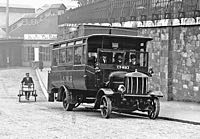
A London and South Western omnibus for Chagford waits in the Queen Street Station yard. This was the only bus from the station. The covered walkway in the rear joined onto the Northernhay path behind the railings.
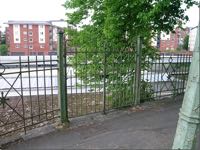
The gate in the iron fence at the Northernhay Walk that allowed access to the covered walkway mentioned in the photo on the left. Courtesy Richard Holladay.
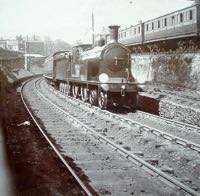
A train working up the bank from St David's Station into Queen Street Station. The St David's Hill tunnel is just around the curve.
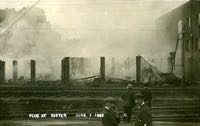
The fire in 1910 at the timber yard mentioned in the text. The fire threatened Queen Street Station.
A tour of Exeter in 1958 from David Cornforth on Vimeo. The first minute shows a Merchant Navy class locomotive pulling into Central Station in 1958.
Exeter in the 1920s part 1 by ExwickDavid
The second feature in this film from about 1925 shows Queen Street Station and many train movements.
│ Top of Page │
